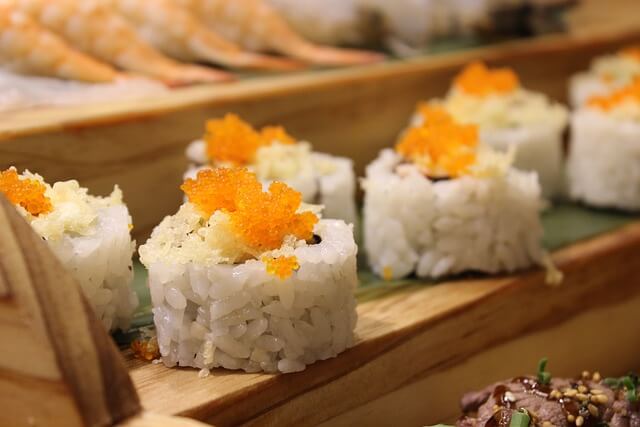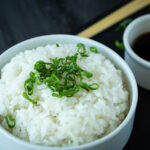Did you know the rice used in making sushi isn’t the regular one you’re used to? Yap, that’s right. If you want to make really great sushi, you must ensure you’re using excellent sushi rice.
The secret to making great-tasting sushi rice lies in several factors. First, choose the right rice variety, ideally Japanese short-grain rice. You should also master perfect seasoning, with vinegar being a key ingredient. Finally, the rice should cook perfectly so that it attains the perfect texture.
Most people find the process of making sushi rice complicated. However, once you get the hang of things, you’ll have it done in no time. This article will highlight the step-by-step process of making excellent sushi rice, offer some tips to help you nail it, and answer some questions about sushi and regular rice.
Sushi vs. Regular Rice: What’s the Difference?
There are different types of rice in the market. The variation is based on the different grain sizes. Rice used in making sushi is usually Japanese short-grain white rice. The primary difference between the short-grain rice and regular rice lies in the texture, cooking method, and stickiness.
For you to make fantastic sushi, the rice needs to be sticky and stay in place. Short grain rice has a higher starch content than long grain rice. Unlike other rice varieties, short-grain doesn’t lose its excess starch after rinsing with cold water. The high moisture content also helps to keep it sticky.
Another significant trait of sushi rice is the seasoning. Sushi rice, known as sumeshi, is usually seasoned using a mixture of rice vinegar and salt to give it a sour taste. However, different chefs and regions usually incorporate other different ingredients into the seasoning.
So how do you prepare delicious sushi rice? Let’s go through each step.
Let’s Cook! Making Great Tasting Sushi Rice
How do you wow your family and guests with your sushi dishes? Here’s the guide you should use to make sushi rice that tastes great. But first, here’s a list of the needed ingredients.
Ingredients (Makes Six Cups of Sushi Rice)
- 2 cups of rice (either sushi or short grain rice)
- 2 cups of water. Add a little extra for the rinsing
- 2 ½ tablespoons of rice vinegar
- 2 tablespoons of sugar
- 1 ½ tablespoon of kosher salt
You can use this quantity calculator if you’d like to try different portion servings.
Let’s now have a look at the steps you should follow when making the sushi rice.
Rinse the Rice
Before doing anything else, you should first rinse the rice. Pour the rice into a bowl and add the cold water. Swirl the bowl to rinse the rice before pouring out the water. Repeat the procedure about two or three more times.
Alternatively, you can use a strainer to rinse the rice. Run it under cold water until the water turns clear. Be sure to drain the excess water once the rice isn’t murky anymore.
Bring the Rice to a Boil
Transfer the rice to a medium saucepan and add the water. If you opt to include kombu, you can add it to the water.
Without covering the top, bring the rice to boil and proceed to change the heat setting to the lowest. At this point, you can cover the saucepan and cook the rice in low heat. You need to cook the rice until it is tender- about 15 minutes will do.
You can also use a rice cooker for this step. If you take this option, you shouldn’t have to worry about regulating the temperature and having the right water measurements. Besides, a rice cooker helps ensure your rice cooks more evenly.
If you’re wondering how to tell when the rice is perfectly cooked, be on the lookout for when it’s fluffy and sticky but retains its shape. You should be able to see a shiny glossy surface on the rice grains if it’s well-cooked. If you find that the rice looks mushy, you probably overcooked it or put too much water in it.
You can also use chopsticks to check whether your sushi rice is ready. Well-cooked sushi rice should form lumps when you pick it up using chopsticks.
Prepare the Sushi Vinegar
As the rice continues boiling, you can begin working on the vinegar mixture.
Start by mixing the rice vinegar, sugar, and salt in a saucepan or bowl. Bring the mixture to boil on the stove for a few minutes over medium heat. Alternatively, heat the mixture for about 45 seconds in a microwave. Ensure you whisk the mixture until all the sugar is dissolved, then set the vinegar aside to cool.
Season the Rice
It’s now time to turn the rice into sumeshi. You can complete this step either in a glass or wooden mixing bowl. You’ll need a spatula to do the mixing, and if you would rather have the complete traditional experience, you can use a rice paddle or a wooden hangiri.
While the rice is still hot, pour the sushi vinegar over it and proceed to mix using your spatula or rice paddle. For proper mixing, gently lift and fold the rice on top of itself to combine with the vinegar thoroughly. Slice the rice at 45° and gently fold it instead of stirring. This way, you’re better able to separate the rice chunks. Keep doing this until the vinegar is well mixed, and most of the initial steam has escaped. You can also use a fan to cool the rice, so it doesn’t get mushy.
Leave the Rice to Cool
The final step in your preparation process is leaving the rice to cool. You can do this by either placing the rice in front of a fan or A/C or let it cool on the counter. Avoid refrigerating.
Cover the bowl with a damp towel or a paper towel. Be sure to let the towel touch the surface of the rice so that it doesn’t dry out.
Serve or Make Sushi and Sashimi
Once the rice is at room temperature, it’s ready for use. You can either serve it immediately in any recipe or use it to make sushi rolls. If there’s any excess, pour it into an airtight food storage container. You can store the remains in the refrigerator for up to three days.
Variations to the Procedure for Making Sushi Rice
Depending on how you want to make the sushi rice, you could always make some variations to the recipe. There are different traditional ways to get to the end goal, therefore, a bit of research and experimenting in the kitchen will help you find the best practices that work for you.
Here are some of the ways you could switch things up a bit.
Soak the Rice Before Cooking
Soaking the sushi rice before cooking can help moisten it better. You can do this for about 30 minutes in the cooking water. After that, bring the rice to boil as usual.
Besides moistening the rice further, soaking also helps it to cook more evenly.
Use Traditional Cooling Methods
Using a wooden hangiri and a rice paddle is a traditional way of cooling the sushi rice. Ensure you transfer the rice to the hangiri immediately after it’s done cooking. Pour the sushi vinegar on top of the rice and use the rice paddle to fold the vinegar into the rice. You can use a Japanese Uchiwa fan to cool the rice quicker as you mix with the vinegar. Cooling it this way helps to give the rice a shine as it cools down.
Why Not Cool the Rice Faster?
Well, if you’re in no position to wait for the rice to cool slowly, you can always hasten the process by using non-traditional methods. Instead of using a wooden hangiri or a mixing bowl, you can transfer the cooked sushi rice to a baking sheet and drizzle the vinegar evenly over the top. Use a spatula to spread out the vinegar and repeat several times until it cools to room temperature.
Add a Natural Sweetener
If you prefer natural sweeteners, you can always ditch the granulated sugar. Instead, honey, coconut sugar, or any other natural product will come in handy. They are also better options if you’re looking to cut down your sugar intake.
Switch Up the Sushi Vinegar Recipe
Depending on how you want your sushi rice to taste, you can always use different amounts of sugar and salt when making the sushi vinegar. Also, increasing or decreasing the amount of vinegar you use will help alter the taste of the sushi rice.
Besides, if you cannot find some rice vinegar, you can always use apple cider vinegar, white wine vinegar, or champagne vinegar instead. However, be warned that the flavor of the rice will be quite different.
You can also buy pre-made sushi vinegar. Unlike regular rice vinegar, sushi vinegar has already been mixed with sugar and salt. You only need to prepare the rice and proceed to pour the sushi vinegar as you would on top of the rice as you cool it.
Tips to Make the Best Sushi Rice
Now that you know how to make some excellent tasting sushi rice, how do you ensure things don’t go wrong? It helps to have these three essential tips at hand.
- Pouring the sushi vinegar over the rice while still hot helps ensure it turns out shiny. Using the Japanese fan to cool the rice as you cool also gives the rice a glossier look.
- Instead of stirring the rice as you pour the vinegar, be sure to cut into it using your spatula.
- When leaving the rice to cool, ensure you have a damp towel over it. The towel helps the rice to maintain its moisture and not dry out. Therefore, it remains sticky, which is essential if you plan on making sushi or sashimi that holds its shape.
Which Is the Ideal Rice Variety for Making Sushi Rice?
Choosing the right rice variety will play a vital role in how your sushi rice turns out. Ideally, you should go for Japanese short-grain rice, and preferably, Koshihikari rice. Shirakiku Rice, Koshihikari is one of the best brands you’ll get online.
However, if you cannot find this particular variety, you can use any Japanese short-grain rice. Another great alternative is medium-grain California rice. If you are totally confused about which rice to pick at the store, then look for “sushi rice” written on the bag of rice, that way you are least likely to go wrong.
The reason the rice variety is so important is that you’ll want your sushi rice to be clamped together and be sticky so that it retains its shape. Short grain rice is preferred because it contains a high amount of starch and moisture hence making it sticky.
It’s not a surprise to find people recommending Jasmine or Basmati rice for making sushi rice. Both of these varieties are long-grain rice, which is usually too dry. They are also not sticky enough to maintain sushi’s shape.
Can You Make Sushi Rice With Regular Rice?
Well, that depends. If by regular rice you mean long-grain white rice, then you might run into some problems. Long grain often has lower starch and moisture content. Therefore, getting this rice to stick together will be a problem. Remember that one of the critical aspects of sushi rice is having the grains clump together.
That said, you can use other types of short grain rice to make sushi (just as we’ve mentioned above). You can also make the rice stickier by carrying out the following steps:
- Skip the rinsing before cooking the rice. Many people opt to wash rice before they cook it. One of the fastest ways to make sure your regular rice becomes stickier is by skipping this step.
Rinsing the rice helps to get rid of the excess starch in the rice. The starch, together with the moisture, is responsible for the sushi rice being sticky. Therefore, rinsing the rice will only make it harder for it to clump together. If you can’t skip this step altogether, you can rinse the rice just once or twice but not until the water is clear so that you still have some starch left.
- Soak the rice before cooking it. Letting the rice soak in a pot of water before cooking it helps to make it stickier. You can leave it soaking for up to 4 hours before cooking. Be sure to drain all the excess water afterward.
- Use a little more water than you need. Add two cups of water to your saucepan. Proceed to add a bit more water than you would need so that the rice becomes clumpy. You can choose to add some salt at this point so that the rice isn’t bland.
- Add rice to the saucepan. The amount of rice you measure will depend on the variety you’re using. If you’re using short-grain rice, add about 1 ½ cups of rice into the saucepan. On the other hand, one cup is the ideal measure for long and medium grain rice. The difference in the measures stems from the different starch content available in the rice. Short grain, which has a higher starch content, will be stickier and clump better than long or medium grain rice.
- Boil over high heat. Bring the rice to boil without covering the top. As the water starts boiling, reduce the heat, and let the rice simmer for about 10 minutes. Cover the saucepan with a lid as the rice continues to simmer.
- Turn off the heat and leave the rice covered on the stove. Once the rice has absorbed all the water, you can turn off the heat and leave the rice covered on the stove. The longer you let the rice sit, the stickier it gets. You can prepare the rice a day or two before you need to use it, in which case you’ll need to cover and refrigerate it so that it doesn’t dry out and spoil.
Although the above steps help make regular rice stickier, you may not have as good an experience as you would with the ideal Japanese sushi rice. Therefore, while you may whip a decent sushi or sashimi dish with this rice, you should be prepared for some different results from what you would achieve with sushi rice.
Why Is Vinegar Used to Season Sushi Rice?
Have you ever wondered why vinegar is used to season Japanese rice? To better understand this, a little history lesson is necessary to trace the origin of sushi.
Sushi literally translates to “sour flavor.” The popular worldwide dish we know today started as a way for the Japanese to preserve their fish. They would store it by wrapping in fermented rice. Whenever they wanted to eat the fish, they would throw away the rice and only cook the fish.
With time, the Japanese found ways to make the fish last longer. Instead of using fermented rice, they began adding vinegar to the rice they used to preserve the fish. Besides increasing the storage period, the vinegar added a unique flavor to the rice. Therefore, they began eating the rice together with the fish. With time, the dish evolved into the sushi that we know today.
Although there’s no need to use vinegar for preservation, it has become an essential ingredient of the worldwide dish. For this reason, many chefs across the world continue using vinegar for seasoning their sushi so that it adds to the dish’s flavors.
How Can You Use Sushi Rice?
So, you’ve made the great tasting sushi, whipped up some fantastic sushi rolls, but you still have some leftover sushi rice. What should you do with it?
Most people don’t know what else they could make with sushi rice besides sushi. If you’re one such person, it’s probably frustrating whenever you have some leftover rice. And let’s face it, you can’t quite nail the right measurements when it comes to rice. Somehow, you’ll always have some left.
Well, the next time you find yourself with some leftover sushi rice, why not try making one of these dishes?
Homemade Mochi
Homemade mochi is an excellent way to make use of the sticky leftover sushi rice. You won’t require to do much for this meal since all you need is to pound the rice into a paste. Depending on the amount of sushi rice you have, you can pour it all in a mortar and use a pestle to pound or introduce it into the mortar in batches.
Have some warm water ready with you as you pound the rice. You can add it to the rice continuously to help retain the consistency. By the time you’re done, the paste should be moist but not watery.
Use potato or rice starch to cover the working surface of your kitchen counter. To ensure that the rice doesn’t stick on your hands, moisten them a little before you start working on the mochi. Place the paste on the surface and start kneading like dough. You can keep adding starch as is needed, so it doesn’t feel too sticky.
Make balls out of the mochi and roll them on the starch layer. You can add the filling of your choice to the mochi balls to boost the flavors. Add as much filling as you want by flattening the balls and stuffing them at the center. You can then eat the mochi at this point or use it to make crispy balls by frying in a pan and toasting on both sides. Serve with soya sauce as a dip or in miso soup so it can absorb all the flavors.
Creamy Pudding
You can also use sushi rice to make some creamy pudding. However, unlike the mochi recipe above, you’ll have to include some other ingredients:
- 2 cups of milk
- 1 egg
- 1 tablespoon of butter
- 1 teaspoon of vanilla extract
- ½ cup of sugar
- Raisins
Pour the milk into a pan and bring it to boil. As it boils, add the vanilla extract and sugar and let it simmer for a few minutes. Add one cup of the reheated leftover sushi rice to the milk and let it cook for about 6 minutes.
Keep stirring the mixture so that the rice doesn’t stick to the bottom. You should also be keen to ensure that it doesn’t burn. You can also add more milk if you need to. Pour in the raisins and let it cook for a few minutes as you keep stirring.
In a separate bowl, beat the egg and mix it with half a cup of milk and salt. Whisk the mixture before adding to the pan and allowing it to simmer for about two minutes. When the pudding is almost done, add the butter and stir it a bit.
You can serve the creamy pudding either chilled or warm, but first, sprinkle some cinnamon on the top. Brown sugar is also an excellent choice for a topping.
Coconut Milk Rice Pudding
If you’d rather go with a more flavored pudding, then you’re going to love this recipe. It’s simple to prepare, and the coconut milk adds flavor to the rice that you’re going to love. Here are the ingredients you should have.
- 3 cups of coconut milk
- 1 cup of condensed milk
- 2 cups of sushi rice
- 4 cloves
- 1 teaspoon of powdered cinnamon
- Dry fruits
Heat the leftover sushi rice in the microwave and add some water so that it becomes mushy.
In a separate pan, add the coconut and condensed milk, cinnamon powder, and clove and boil on low heat as you stir. You’ll notice the milk starts thickening.
Add the sushi rice and dry fruits when the milk is slightly thick. Allow it to cook on low heat for about six minutes. During this time, keep stirring so that the rice doesn’t stick to the bottom.
You can then serve the pudding while warm, wait for it to get to room temperature, or chill it in the refrigerator. The colder it gets, the thicker it will be. Therefore, you can serve it depending on the thickness you want to achieve.
Parting Shot
Although many people think making sushi rice is complicated, you only need to do it a few times to master the art. You also have to ensure you have the right rice, the necessary ingredients, and follow the right steps and tips to ensure you don’t go wrong.
Here’s a summary of how to make great-tasting sushi.
- Choose the right rice variety. Preferably, go for Japanese short-grain rice.
- Rinse the rice before bringing it to a boil
- Prepare the sushi vinegar by mixing the rice vinegar, salt, and sugar in a saucepan.
- Season the rice and leave it to cool to room temperature before serving it.
Making sushi rice is a straightforward process, and after a few tries, you could be a pro. Why don’t you try the above recipe and experiment with the different dishes you could make from the rice?
Sources
- Food Network: Recipe for Sushi Rice
- Amazon: Hangiri Sushi Oke Rice Mixing Tub with Lid
- Make My Sushi: Perfect Sushi Rice
- Gimme Some Oven: Sushi Rice
- Facebook: Sushi King
- WikiHow: Make Sticky Rice Using Regular Rice
- Chopstick Chronicles: How to Make Perfect Sushi Rice
- Just One Cookbook: How to Make Sushi Rice
- Just One Cookbook: Japanese rice- Everything You Need to Know
- Quora: What’s the difference between sushi rice and white rice?
- Easy Homemade Sushi: How to Use Leftover sushi Rice Besides Making Sushi



